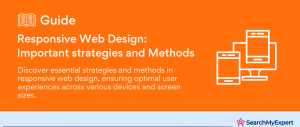Mobile-First Design
In today’s digitally-driven world, mobile-first design is not just a buzzword but a fundamental approach that is shaping the future of web engagement. This design philosophy prioritizes the creation and structuring of websites and applications for mobile devices before making adaptations for desktop or larger screens. The growing importance of mobile-first design is rooted in the increasing reliance on smartphones and tablets for internet access globally.
Why Mobile-First Design Matters More Than Ever
- The Shift in User Behavior: Statistics show a significant shift towards mobile internet usage, with a large portion of global web traffic now originating from mobile devices. This shift underscores the need for businesses to prioritize mobile user experience to remain relevant and accessible.
- Enhanced User Experience:
Mobile-first design focuses on delivering a streamlined and efficient user experience. By designing for smaller screens with touch interfaces, businesses ensure that their content is easily accessible, readable, and navigable on mobile devices, leading to a more satisfying user experience. - Improved Website Performance:
Websites designed with a mobile-first approach tend to load faster and perform better on mobile devices. This is crucial, as loading time is a key factor in user engagement and retention. - Better Search Engine Rankings:
Search engines like Google prioritize mobile-friendly websites in their search results. A mobile-first design can thus improve a website’s search engine optimization (SEO), making it more visible and accessible to potential customers. - Future-Proofing Your Online Presence:
With the continuous evolution of mobile technology and increasing mobile internet consumption, adopting a mobile-first design is a proactive step towards future-proofing a business’s online presence.
Decoding the Mobile User Journey
The mobile user journey is a complex yet fascinating process that involves various interactions, expectations, and behavior patterns. Understanding this journey is crucial for businesses and designers to create user-centric mobile experiences.
Analyzing User Interaction with Mobile Devices and Apps
- Touch Navigation:
Mobile users predominantly rely on touch for navigation. This includes tapping, swiping, and pinching, which are intuitive actions but require thoughtful design to ensure ease of use. - Limited Screen Real Estate:
Users interact with smaller screens on mobile devices, which necessitates a design that prioritizes essential content and functionality. - Contextual Usage:
Mobile devices are used in various contexts – while commuting, in between tasks, or during leisure time. This impacts how and when users interact with apps and websites.
Identifying Common Pain Points and User Expectations
- Slow Load Times:
Mobile users often experience frustration with slow-loading apps or websites. Quick access is a key expectation. - Navigation Challenges: Overly complex or unclear navigation can lead to user frustration, emphasizing the need for a simple and intuitive user interface.
- Readability Issues: Small text or cluttered information can be a deterrent for mobile users, who expect clear and easily digestible content.
- Lack of Mobile Optimization: Websites or apps not optimized for mobile can lead to poor user experiences, such as having to zoom in to read content or interact with features.
Understanding Key Mobile User Behavior Patterns
- Shorter Attention Spans:
Mobile users typically have shorter attention spans, favoring quick and straightforward interactions. - Frequent but Brief Interactions:
Users often engage with mobile devices frequently throughout the day, but these sessions are usually brief. - Preference for Visual Content: Mobile users show a preference for visual content like images and videos, which are more engaging on smaller screens.
- Social Media Integration: The integration of social media is crucial, as many mobile users frequently access these platforms and expect seamless sharing capabilities.
Mastering Mobile-First Design
Designing for small screens first is a pivotal aspect of the mobile-first approach. It involves a strategic focus on prioritizing content and functionality that is essential for mobile users, ensuring clarity in the visual hierarchy, and optimizing touch interaction and navigation.
Prioritizing Essential Content and Functionality
- Streamline Content:
Identify the most critical information and functionalities that mobile users need. Eliminate anything that does not serve a direct purpose or enhance user experience. - Optimize for Mobile Tasks: Understand common tasks users perform on mobile and make these tasks straightforward to complete. For instance, simplify forms and make call-to-action buttons easily accessible.
- Responsive Images and Media: Ensure that images and videos are optimized for mobile, loading quickly and fitting neatly within the screen dimensions.
Creating a Clear and Concise Visual Hierarchy
- Size and Scale:
Use size, contrast, and color effectively to guide users’ attention to the most important elements. - Legible Typography:
Choose fonts that are easy to read on small screens and use adequate spacing to improve readability. - Simplify Navigation:
Design a navigation system that is intuitive and unobtrusive. Menus should be accessible but not take up too much screen space.
Ensuring Easy Touch Interaction and Navigation
- Touchable Targets:
Make buttons and links large enough to be easily tapped with a finger. The recommended size for touch targets is at least 44 pixels square. - Gesture-Friendly Design: Accommodate common gestures like swiping and pinching. Ensure that these gestures do not conflict with each other or make navigation confusing.
- Scrolling Over Clicking:
Favor scrolling over clicking to reveal more content. It’s easier and more intuitive for mobile users to scroll than to locate and click on small links.
Progressive Enhancement
Progressive enhancement in web design means starting with a solid, functional mobile-first base and then adding more complex features and functionalities that are suitable for larger screens. This approach ensures that users have a seamless and consistent experience across all devices, from smartphones to desktops.
Building on the Mobile-First Design for Larger Screens
- Scale Up Responsively: Begin by scaling up the basic mobile design. Utilize media queries in CSS to adjust layouts, font sizes, and other elements to fit larger screens effectively.
- Enhance Layouts:
Introduce multi-column layouts for larger screens where content can be displayed more expansively, taking advantage of the additional space. - Optimize Navigation: While dropdown or hamburger menus work well on mobile, larger screens offer the opportunity to display more extensive navigation bars or side menus.
Adding Additional Features and Functionality
- Leverage Advanced Interactions:
On larger screens, incorporate hover effects, animations, and other interactive elements that aren’t practical on mobile devices. - Enhanced Graphics and Images: Utilize higher resolution images and more complex graphics that are better suited for larger displays.
- Incorporate Additional Content: Where appropriate, add more detailed content like sidebars, additional information sections, or advanced filtering options that can enhance the user experience on larger screens.
Maintaining Consistency Across Devices
- Unified Design Language:
Keep a consistent look and feel across all devices. This includes maintaining a consistent color scheme, typography, and design elements. - Consistent User Experience:
Ensure that functionalities and features are consistent across devices. For example, if a feature is introduced on the desktop version, consider how it translates or is replaced on mobile. - Seamless Transition:
The transition from mobile to desktop should feel natural. Users should be able to switch devices without relearning how to navigate the website or app.
Maximizing Mobile Performance: Speed and Responsiveness Optimization
In the realm of mobile-first design, optimizing for performance and speed is crucial. Fast loading times and smooth responsiveness are not just conveniences but necessities in retaining user attention and engagement. This step focuses on implementing strategies to ensure websites and apps are lightweight, fast, and adaptable to various network conditions.
Ensuring Fast Loading Times and Smooth Responsiveness
- Optimize Image Sizes: Use compressed images that are appropriately sized for mobile without compromising on quality. Tools like TinyPNG or JPEGmini can be effective for this purpose.
- Minimize HTTP Requests: Reduce the number of server requests by minimizing the use of scripts, fonts, and plugins. Combine CSS and JavaScript files where possible.
- Use of Content Delivery Networks (CDNs): Employ CDNs to distribute the load, reducing latency by serving files from servers closest to the user.
Using Lightweight Design Elements and Optimized Code
- Simplify CSS and JavaScript: Streamline code by removing unnecessary characters, spaces, and comments. Use minified versions for production.
- Leverage Browser Caching: Make use of browser caching to store frequently accessed resources on the user’s device, which speeds up subsequent page loads.
- Asynchronous Loading:
Implement asynchronous loading for JavaScript and CSS to prevent render blocking, allowing the page to render more quickly.
Considering Different Network Conditions and User Contexts
- Responsive to Network Quality:
Design the website to be functional and presentable even on slower networks. Use adaptive image loading techniques, where image quality adjusts based on the network speed. - Progressive Web App (PWA) Approach:
PWAs can provide a near-native app experience, working offline or on low-quality networks, thus enhancing mobile performance. - User Context Consideration: Acknowledge that mobile users may be in varying contexts (e.g., outdoors with limited connectivity) and ensure the design is robust enough to handle these scenarios.
Ensuring Excellence through Testing and Iteration
Testing and iteration are fundamental in the development of a successful mobile-first design. This phase ensures that the product not only meets the initial design specifications but also addresses the real-world needs and preferences of its users.
Conducting Comprehensive Testing Across Devices and Systems
- Diverse Device Testing: Test on a wide range of mobile devices, including various brands, screen sizes, and operating systems, to ensure compatibility and consistent user experience.
- Operating System Variations:
Consider the different versions of mobile operating systems (iOS, Android, etc.) and test for functionality and performance on each. - Simulate Real User Environments:
Use tools to simulate different network speeds, screen resolutions, and user interactions to see how the design performs under various conditions.
Gathering and Incorporating User Feedback
- User Feedback Loops: Implement mechanisms to collect user feedback, such as surveys, focus groups, and usability tests. This feedback is invaluable for understanding user satisfaction and areas for improvement.
- Data-Driven Iteration:
Use analytics to track user behavior and identify patterns or issues. Make informed decisions about design changes based on this data. - Iterative Design Process:
Adopt an agile, iterative approach to design, allowing for continuous improvements and refinements based on user feedback and changing trends.
Continual Enhancement of the Mobile Experience
- Ongoing Optimization:
Regularly update the mobile experience to keep up with new technologies, user expectations, and emerging design trends. - Responsive Design Adjustments: Continuously tweak and adjust the responsive design elements to ensure optimal performance across all devices and screen sizes.
- Data and Insight Utilization:
Leverage user data and industry insights to anticipate needs and preferences, staying ahead of the curve in mobile design
Embracing a Mobile-First Culture in Your Organization
Adopting a mobile-first mindset is a strategic move for any organization aiming to thrive in today’s digital landscape. This involves a cultural shift and an educational journey for all involved in the product development process.
Cultivating a Mobile-First Culture
- Organizational Buy-in:
Encourage the adoption of a mobile-first philosophy at all levels of the organization. Highlight the benefits and necessity of this approach in the current digital era. - Showcase Success Stories: Share case studies and examples of successful mobile-first strategies within the organization to inspire and motivate.
- Encourage Cross-Departmental Collaboration: Foster a collaborative environment where designers, developers, and marketers work together with a unified mobile-first focus.
Training on Mobile-First Principles
- Educational Workshops:
Conduct workshops and training sessions to educate teams on the principles and best practices of mobile-first design. - Resource Sharing:
Provide access to resources, tools, and literature on mobile-first strategies and trends. - Skill Development Programs: Offer opportunities for skill enhancement in areas critical to mobile-first design, such as responsive coding, UX design, and performance optimization.
Integrating Mobile-First Thinking into Product Development
- Early Integration in the Process:
Embed mobile-first considerations at the outset of the product development cycle, from concept to deployment. - Continuous Learning and Adaptation:
Encourage teams to stay informed about the latest mobile technologies and design approaches, adapting these into their workflow. - User-Centric Approach:
Keep the focus on the end-user throughout the development process, ensuring that every decision made aligns with providing the best possible mobile experience.
Conclusion:
In conclusion, mastering mobile-first design is a journey that involves understanding and prioritizing the unique needs of mobile users, optimizing content for small screens, progressively enhancing the experience for larger devices, and ensuring high performance and speed. It also requires rigorous testing and iteration based on user feedback and fostering a mobile-first mindset within your organization.
Adopting these strategies is not just about keeping up with current trends; it’s a fundamental shift in approaching web design and development. By embracing a mobile-first approach, businesses and developers can create digital experiences that are not only visually appealing and user-friendly but also efficient and effective across all devices. This holistic approach ensures that your digital presence is robust, engaging, and future-proof in an increasingly mobile-centric world.
Navigate the web’s future with top Web Design Agencies.
Table of Contents
Toggle






